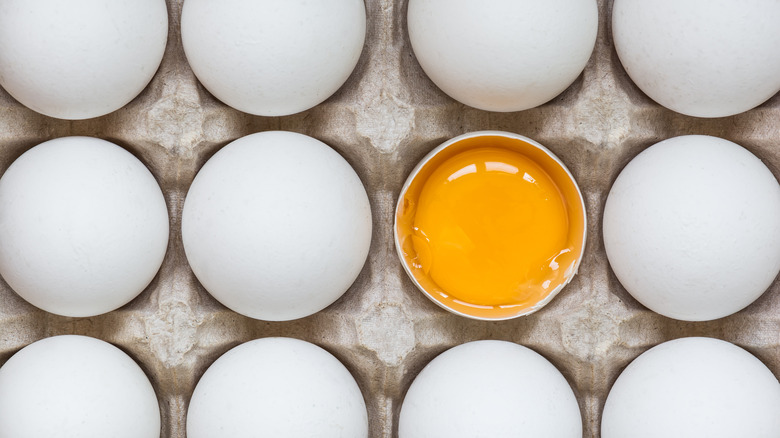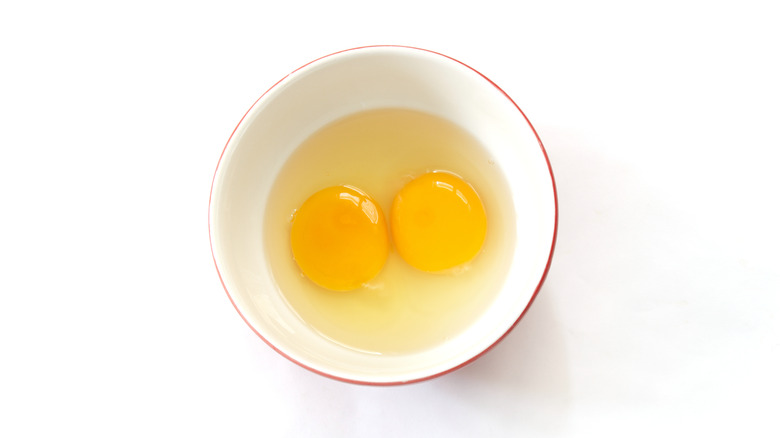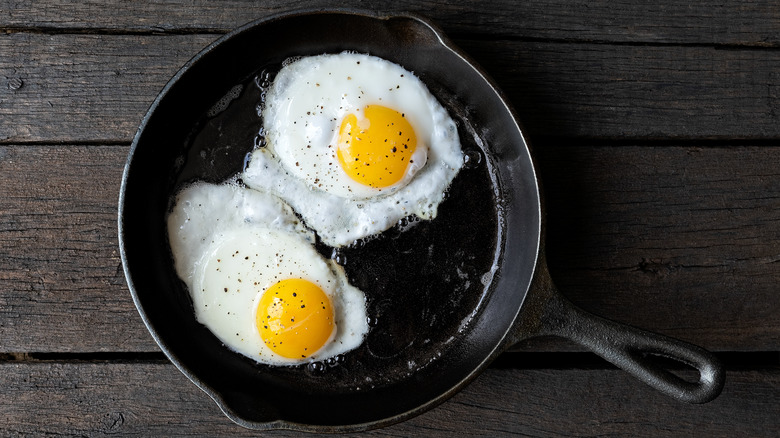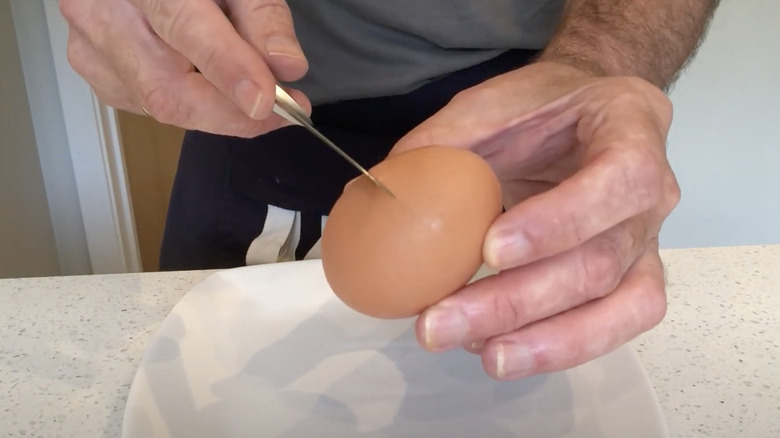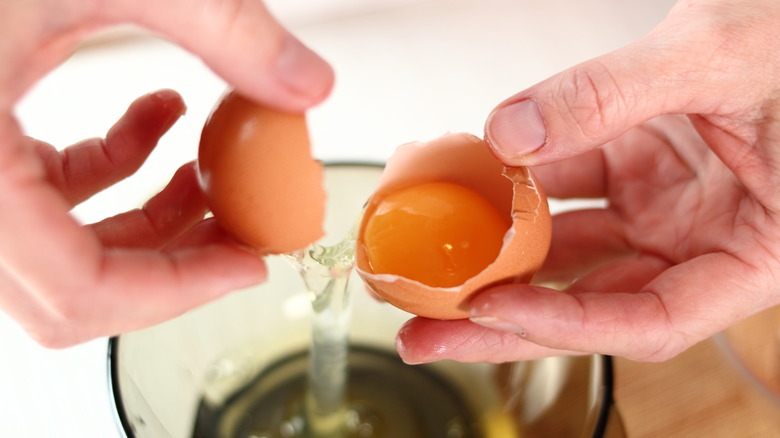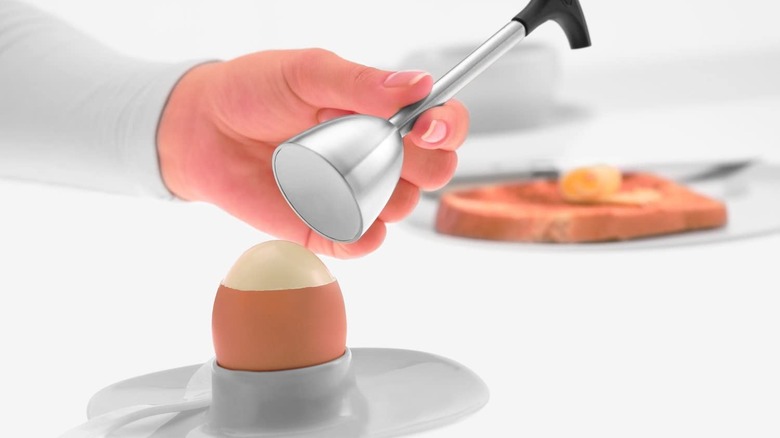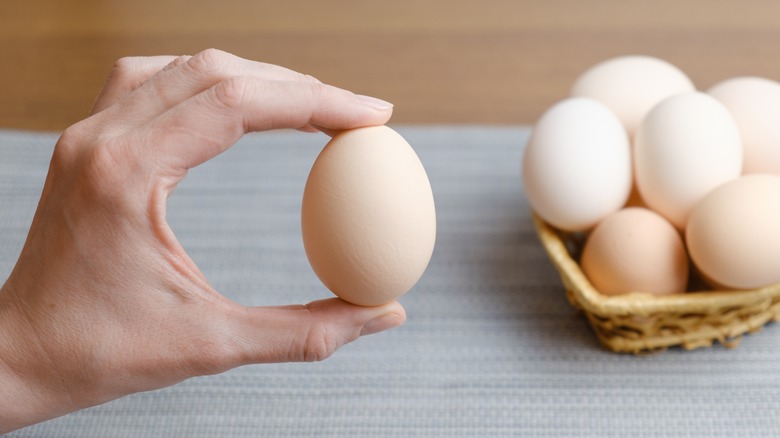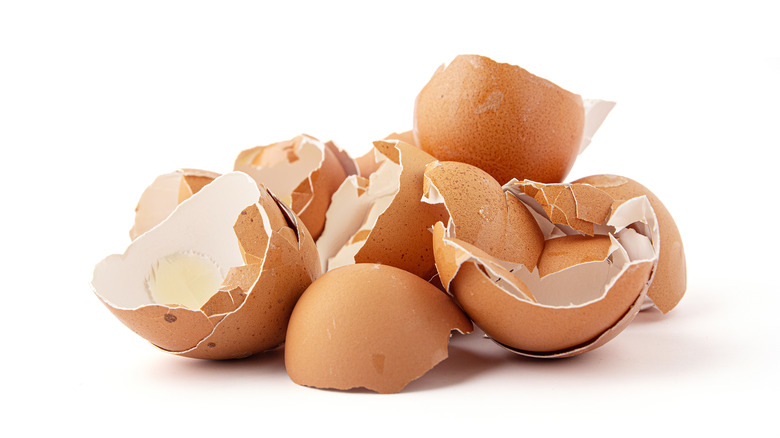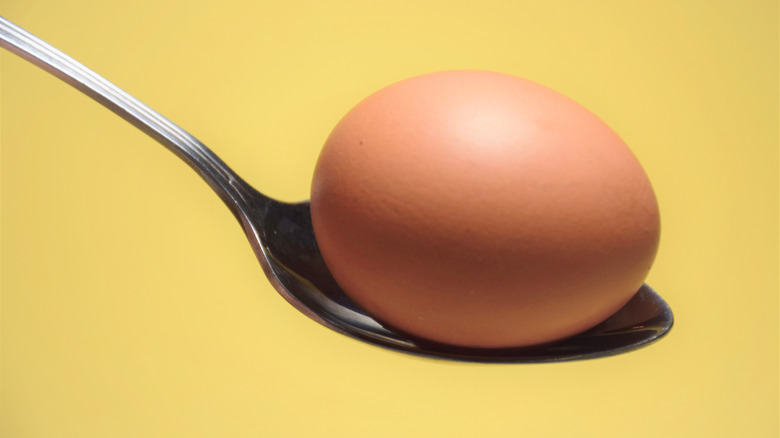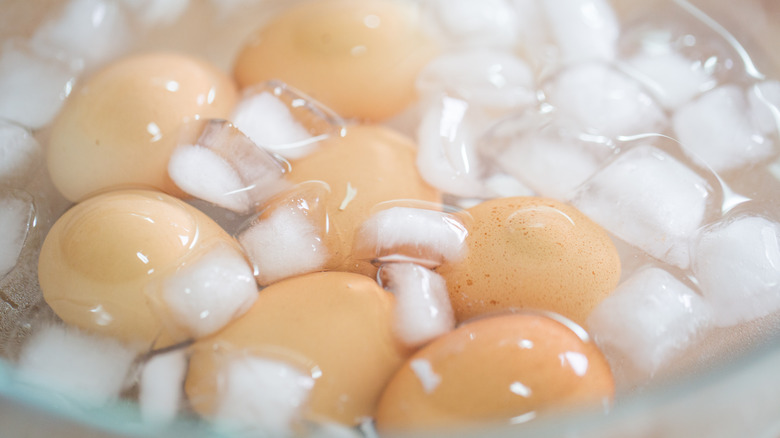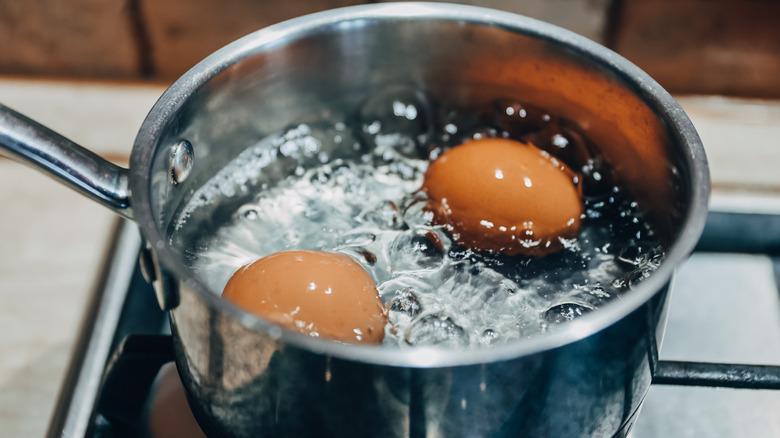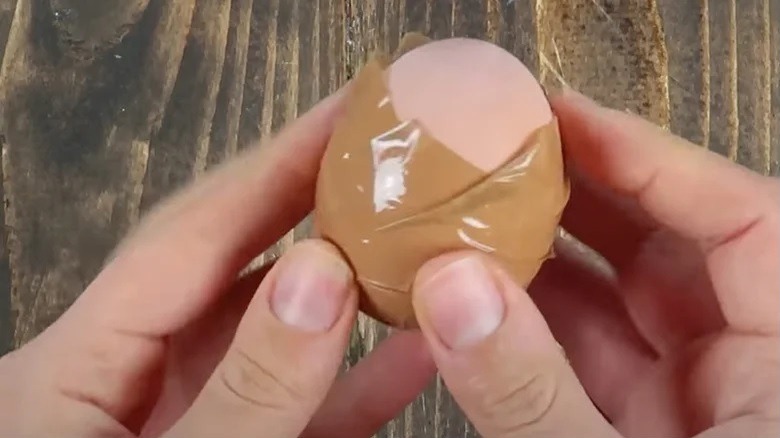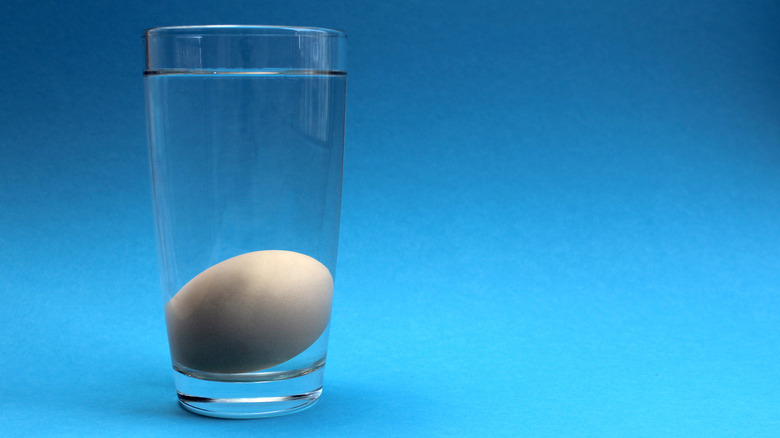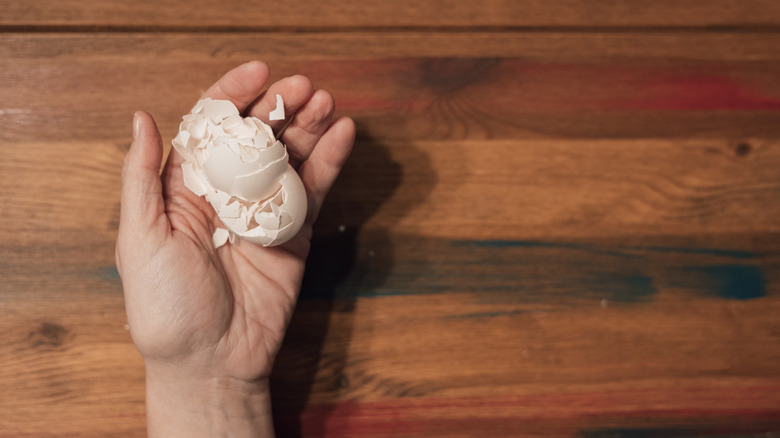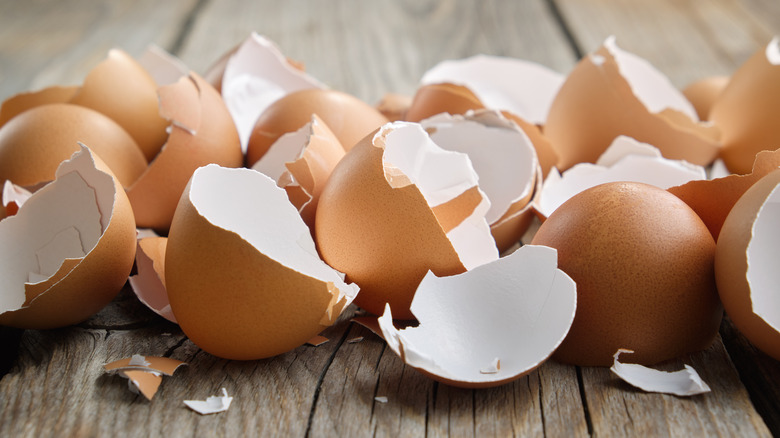13 Hacks That Will Help You Perfect Eggshell Cracking
We may receive a commission on purchases made from links.
Whether you're preparing breakfast or an afternoon snack, one of the trickiest things to learn when cooking eggs is how to crack the shells while keeping the contents intact. At any given moment, the slightest mishandling can ruin the deliciousness waiting within. Anyone who's ever made an egg knows how it feels to ruin the yolk-y goodness. A little too much pressure and ... kaput! Approach the crack from the wrong angle and you lose a third of it to the sides of your frying pan. Not to mention, a piece shell may end up going rouge, adding unwanted extra crunch to your meal.
From over-easy to hard-boiled, whichever your eggs-perience, one thing's for sure: a perfectly cracked shell will have you on the sunny side up. Thankfully, we've got your back. To get you on the right track, we've hatched a plan to help you perfect the art of cracking eggs. With these hacks, the only thing that'll crack under pressure are the shells.
Crack shells into separate bowl to avoid contamination
One of the most commonly overlooked things when it comes to cracking eggshells is potential contamination. That's why it's very important to handle and cook eggs properly. While commercially sold eggs are washed beforehand, you should still be mindful because sometimes salmonella can slip through the cracks.
Unfortunately, it can be tough to determine if you ended up with a bad egg in your carton simply by observing the shells. That's why you should always crack eggs in a separate bowl from your other ingredients. It'll make it easier to spot bad eggs that can annoyingly cause you additional prep time. (Let's be honest, no one likes starting over from scratch.) Along with using a separate bowl, you should also crack one egg at a time so you get a good look at each individual yolk. Although it may take a bit longer, patience in the kitchen can do wonders for a recipe's end result.
Drop your egg into a pan
In life, sometimes we have the habit of making things harder than they need to be. That's especially true when it comes to cracking eggs. Though it may seem counterintuitive, one of the easiest, most foolproof ways to successfully crack an egg is to simply drop it into a pan. It's unclear why you're unlikely to find this viral hack in cookbooks or see it on your favorite cooking show. Professional chefs love to put on a show, so maybe this straightforward approach lacks that extra bit of panache.
All you need to do is grab an egg, position your handle no more than a foot above the center mark of your pan, then let go. You'll find that gravity provides just the right amount of pressure for a mess-free clean crack, allowing you to easily remove and discard any rogue eggshells. Of course, this method doesn't work when you're baking or making a recipe that requires mixing eggs with other ingredients.
For more controlled cracking, use a knife
Another method you can take a crack at is by using a palette knife. If you apply the right pressure and placement, it'll be over easy in no time. The edge of a palette knife is best for reducing stray eggshells and damaged yolks. While recommended, it's most often used for baking, so if you don't own one, a butter knife will also suffice. To help fully stocked home chefs, and those who prefer sticking to the basics, we'll cover the correct way to use both utensils.
When using a palette knife, the first step is to hold your egg in the proper position: The narrower end should face your fingers. The goal is to gently strike the "waistline" of the eggshell with the blade edge. If done right, you'll create a clean line-shaped crack in the center that you can use to separate the two halves with little force. It should also help you avoid eggshell pieces and damaged yolks. For butter knives, use the same technique, except make sure the blunt edge of the blade is used rather than the sharp one.
Tap the shell against the rim of a bowl
This next eggshell cracking hack isn't the cleanest method but is proven to secure your yolk. Home cheffing can take you to unexpected places, which means that sometimes getting the job done requires getting a little messy. Whether you savor a scramble, or prefer a poach, you'll need to use a bowl for preparation. When the recipe calls for one, all you have to do is crack the egg against the rim. The tricky part is making sure you hit the egg in the right spot, and with the right force.
No matter your approach, being gentle is key. In this case, always tap the eggshell gently against the rim of the bowl, and make sure that you're aiming as close to the center as possible. Once you've successfully made a small crack, work your thumbs into the opening to separate the two halves. If the crack landed in the right spot, the eggshell should come apart with ease. It may take a few tries to get it perfect, but don't worry, practice will get you there.
Cleanly remove shell-top with an egg topper
If you want to fancify your eggshell-cracking skills, there happens to be a tool made specifically for the job: an egg topper. Someone was clearly fed up with yolky messes when this special gadget (which is also referred to as was created. Made from stainless steel, the device features two pieces that work in tandem to secure then open eggshells. Simply rest an egg into the egg-shaped holder, place the cracker tool on top, pull the lever upward, and just like that, you're good to go.
It seamlessly removes the tops of not only hard-boiled eggs, but soft-boiled, and non-boiled ones too. That said, there is a tiny learning curve, as using the release on the cracker takes some trial and error. The trick is to let the lever snap back after you pull it upward. Once you have it down, the clean cut is definitely a sight to behold; it's mess-free and perfectly intact. The only drawback is that it's not a one-size-fits-all tool. Minor flaws aside, its affordability (we happen to be fans of the egg topper from Rösle) makes it worth keeping around in your kitchen.
Try the one-handed technique
Knowing how to prepare delicious eggs is a basic skill every home chef should have. While it'd be amazing knowing how to easily whip up a Gordon Ramsay-level beef wellington, or to bake a superb quiche Lorraine that rivals Julia Childs', sometimes we forget that the chefs we look up to the most, all stress knowing the basics. That said, now that we've covered the basics, it's time to up the ante. This next technique might just be the most challenging eggshell cracking hack of all: the one-handed eggshell crack.
Odds are you've seen it in a movie or on your favorite cooking show. Now you'll learn how to master it and impress. Chef Kelly Scott demonstrates the steps in a TikTok video, beginning with the correct hand position. First, you'll need two eggs; hold one between your index, middle, and thumb. Secure the other against your palm using the ring and pinky fingers. Next, take a quarter coin, and use the two eggs to practice gripping and releasing it. This move mimics separating two eggshells.
She recommends practicing at least 30 times before trying the technique out. After you've got it down, grab a bowl because it's time to test it out. Remember that when you tap the egg against the bowl's rim, aim for the shell's waistline. Two gentle taps should suffice. Perform the grip and release technique, and you should end up with perfectly intact yolks in your bowl.
Pull the shell outward rather than inward
It's the steps of a process that can make or crack your eggshell. Some hacks get the job done clean and efficiently; others leave a bit of a mess yet work just fine; and some are just simply cool looking. Whichever method gets you eggs-cited, something to keep in mind about each is how you should actually remove cracked shell pieces. Fragile and jagged eggshells are, ironically enough, protective and simultaneously harmful to the contents inside.
One easily overlooked mistake you can make when cracking eggs is to push the cracked shell inward. It almost seems contradictory, because in order to crack it, you have to apply force against the shell. That's why it's important to tap the egg gently. After the initial crack, carefully pull each end outward rather than inward. Following this method will help to ensure that you end up with a perfectly preserved yolk.
Take off cracked eggshells with a spoon
While the jury's still out on which method is the best for egg cracking, another popular one is by using a spoon. Reserve this move for soft and hard-boiled eggs only, as fresh ones will definitely cause a splatter. When your eggs are cool and ready, grab one so the bottom of the shell is facing upward. Gently tap the shell with the bottom of your spoon, then remove the cracked pieces until you expose an area the size of a quarter. You can also tap it against a flat surface.
The spoon should fit into the shell opening and against the round shape of the cooked egg. From there, move the spoon around the egg in a complete circle, which will separate it from the membrane, making it easy to remove so you can enjoy your soft or hard-boiled snack in all of its glory.
Submerge your eggs in ice water for easy removal
Let's keep it real: It always a massive letdown when you boil an egg to perfection, only to snag a chunk of the white off while removing the shell. Sadly, it happens all too often. Even if an imperfect-looking egg isn't make or break for enjoying a hearty cobb salad or savory deviled eggs, you can't deny that aesthetics make a difference. Great-looking plating is not only appealing, one could even argue that it makes for a tastier experience.
One of the best ways of removing the shell without ruining that lovely oval shape is by submerging hard-boiled eggs in an ice bath. Ice allows the piping-hot eggshell to cool down. (For obvious reasons, you wouldn't want to try cracking it fresh out of the pot.) When they're suitable to pick up, place them into a bowl of room-temperature water. Next, make the initial crack against the rim of the bowl, then peel the remaining shell pieces off underwater. Not only will water help the eggshell's membrane detach from the egg whites, but it will also make the process quick and clean.
Soften eggshells by adding salt and vinegar to water
Cooking is truly a science. If you think about it, it's probably one of the funnest ways to experiment. Whether or not that was on the mind of the person who discovered how eggshells react to salt and vinegar, isn't known. Nevertheless, that discovery alone has helped many home chefs successfully make excellent boiled eggs. When vinegar comes into contact with eggshells, it causes the outer layer to dissolve. Mixing it with water and salt has the effect of tempering the reaction, which causes the shell to only soften, rather than break down.
Salt adds density to water so that when eggs are added, they sink to the bottom of the pot. The combination of salt waterand vinegar is an essential part of a hard-boiling egg recipe and a downright genius combination that makes peeling shells super easy. All you need is a quarter cup of vinegar and a teaspoon of salt to make the medicine go down.
Wrap tape around cracked eggshells
Easily one of the most inventive ideas for your shell-removal needs, using tape to peel an egg might just become your go-to hack. Before giving it a try, make sure you've allowed the eggs to cool down to room temperature. We suggest you use packing tape, as other kinds may lack the necessary adhesive strength or be overly sticky and ruin the egg altogether. Because this isn't the most delicate approach, one option is to let your fresh eggs age a week before attempting. Aged eggs are easier to separate because they have a weaker bond between the shell and membrane.
With tape wrapped around the entire eggshell, gently roll the eggs atop your kitchen counter using the palm of your hand. Applying just the right amount of pressure should crack the outer shell without damaging the egg white. After you've rolled it, the eggshell pieces should come off as you slowly peel the tape.
Shake egg inside glass of water to separate shell
While this might be the best way to peel an egg, it's arguably the most fun. All you need is a small glass cup and a bit of water. As demonstrated in a YouTube video from MicahMedia, it has to be done over your kitchen sink, because there's a good chance of making a wet mess. Holding the water-filled cup in your hand, place a boiled egg inside, and make sure your fingers cover the cup's opening. Next, shake, shake, and shake some more until the shell fragments. The pressure from water swishing back and forth loosens the egg from the shell's membrane.
It's not the cleanest approach, but hey, a splash of cool water never hurt anyone. Fortunately, there's also a mess-free way to try this de-shelling technique: use tupperware. With the water secure inside of a container, you can shake it like a salt shaker without worry. It also allows you to use more than one egg at a time.
Roll the shell under your palm to loosen
One of the more common ways to easily peel and loosen hard-boiled eggshells is by rolling it on a flat surface under your palm. Make sure your eggs are at room temperature before trying, then place one on the kitchen counter, and apply careful pressure with your palm as you roll it back and forth. Doing so will gradually crack the eggshell into tiny fragments, making them easy to pick off. The pieces should end up small enough that the egg white isn't snagged away as you remove the shell.
It goes without saying that the last thing anyone wants is a lumped up, uneven hard-boiled egg. While this method works great, depending on how many eggs your recipe requires, it may not be the quickest way. But when you have time on your hands to test out some culinary hacks, definitely give it a try.
Crack eggs on flat surface to avoid shell pieces
By now you may have already decided which eggshell-cracking hack suits your culinary style. But before you settle, try out Gordon Ramsay's super simple eggshell hack of choice: using a flat surface. While Ramsay doesn't specify which flat surface is recommended, we believe a cutting board is the best option for the purposes of a cleaner crack. Once you're finished, you can easily wash away any remnants of yolk in your kitchen sink.
If by some rare happenstance you don't own a cutting board, then a countertop is more than capable. It works the same as the frying pan method, except you should hold the egg no more than half a foot above the surface rather than a foot. Then let gravity do the rest. The height difference will crack the egg slightly, keeping the contents inside rather than releasing them onto your countertop. From there, you can easily crack the eggshell open into a mixing bowl.
